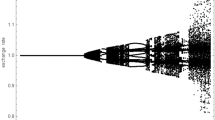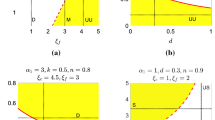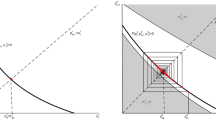Abstract
The dynamics of a pure exchange overlapping generations model with endogenous money growth rule is investigated. We consider a nonlinear monetary policy rule which, in each period, bounds the money growth rate so that money is determined by the deviation of the inflation rate from its target. More precisely, we introduce such a mechanism through a sigmoidal money adjustment mechanism characterized by the presence of two asymptotes that bound the money variation, and thus the dynamics. It is shown that, depending on the timing of the monetary policy and the degree of reaction of the Central Bank, the target equilibrium may be destabilized via different types of bifurcations. Multistability and coexistence of attractors may also occur and the study of the basins of attraction allows us to analyze the global dynamic properties of the economy under scrutiny. We find that active monetary policy rules may be relevant for their stabilizing properties, but they also may open the door to equilibrium cycles of any periodicity and even chaos.








Similar content being viewed by others
Notes
1Clarida and Gertler (1997) report empirical evidence about the strategy of leaning against the wind pursued by the Bundesbank during the eighties and nineties in the sense that it tightens monetary policy if inflation (and output) are rising.
Qualitatively represented in Fig. 4 with dashed curves.
Since we consider the case in which the monetary equilibria are smaller than π a, the transcritical bifurcation of the autarkic steady state does not occur in our framework.
6See Medio and Lines (2001)
It is indeed possible to prove a statement similar to Proposition 5 with analogous technique.
We do not consider such an eventuality because it does not belong to the Samuelson case.
In general, function g is invertible if \(\delta >\frac {2}{\pi ^{*}-\pi ^{a}}\) but, for the purpose of discussion, we distinguish the cases δ > 0 and δ < 0.
From a speech given at College Foundation, October 27, 1998.
References
Agliari A (2006) Homoclinic connections and subcritical Neimark bifurcation in a duopoly model with adaptively adjusted productions. Chaos Soliton Fract 29:739–755
Allen RGD (1967) Macro-economic theory: a mathematical treatment. St. Martin’s Press, New York; Macmillan, London
Andersson M, Hoffman B (2009) Gauging the effectiveness of quantitative forward guidance: evidence from the inflation targeters. ECB Working Paper No. 1098
Arthur WB (1994) Increasing returns and path dependence in the economy. University of Michigan Press
Benhabib J, Schmitt-Grohé S, Uribe M (2001a) Monetary policy and multiple equilibria. Am Econ Rev 91:167–186
Benhabib J, Schmitt-Grohé S, Uribe M (2001b) The perils of Taylor rules. J Econ Theory 96:40–69
Benhabib J, Schmitt-Grohé S, Uribe M (2002) Chaotic interest-rate rules. Am Econ Rev 92:72–78
Bernanke B S, Woodford M (1997) Inflation forecasts and monetary policy. J Money Credit Bank 29:653–684
Bischi G I, Marimon R (2001) Global stability of inflation target policies with adaptive agents. Macroecon Dyn 5:148–179
Bullard J (1994) Learning equilibria. J Econ Theory 64:468–485
Bullard J (2012) Inflation targeting in the USA. Speech at the Union League Club of Chicago, February 6, 2012
Carlstrom CT, Fuerst TS (2000) Forward-looking versus backward-looking taylor rules (no. 0009). Federal Reserve Bank of Cleveland
Castro V (2011) Can central banks’ monetary policy be described by a linear (augmented) Taylor rule or by a nonlinear rule? J Financ Stability 7:228–246
Chen H J, Li M C (2009) Habit formation and chaotic dynamics in an n-dimensional cash-in-advance economy. Nonlinear Dynam 58:49–62
Clarida RH, Gertler M (1997) How the bundesbank conducts monetary policy. In: Reducing inflation: motivation and strategy. University of Chicago Press, pp 363–412
Clarida R, Galí J, Gertler M (1999) The science of monetary policy: a new keynesian perspective. J Econ Lit 37:1661–1707
Creel J, Hubert P (2015) Has inflation targeting changed the conduct of monetary policy? Macroecon Dyn 19:1–21
Debreu G (1974) Excess-demand functions. J Math Econ 1:15–21
Dolado J, Pedrero R M D, Ruge-Murcia F J (2004) Nonlinear monetary policy rules: some new evidence for the US. Stud Nonlinear Dyn E 8:2
Dolado J, Mara-Dolores R, Naveira M (2005) Are monetary-policy reaction functions asymmetric? The role of nonlinearity in the Phillips curve. Eur Econ Rev 49:485–503
Du J G, Huang T, Sheng Z (2009) Analysis of decision-making in economic chaos control. Nonlinear Anal-Real 10:2493–2501
Fanti L, Gori L, Sodini M (2013) Complex dynamics in an OLG model of neoclassical growth with endogenous retirement age and public pensions. Nonlinear Anal-Real 14:829–841
Gardini L, Hommes C H, Tramontana F, De Vilder R (2009) Forward and backward dynamics in implicitly defined overlapping generations models. J Econ Behav Organ 71:110–129
Goeree JK, Hommes C, Weddepohl C (1998) Stability and complex dynamics in a discrete tâtonnement model. J Econ Behav Org 33:395–410
Grandmont J M (1985) On endogenous competitive business cycles. Econometrica 53:995–1045
Holyst J A, Hagel T, Haag G, Weidlich W (1996) How to control a chaotic economy? J Evol Econ 6:31–42
Hommes CH (2013) Behavioral rationality and heterogeneous expectations in complex economic systems. Cambridge University Press
Ingram W T (2002) Invariant sets and inverse limits. Topol Appl 126:393–408
Kopel M (1997) Improving the performance of an economic system: controlling chaos. J Evol Econ 7:269–289
Mantel R (1974) On the characterization of aggregate excess-demand. J Econ Theory 7:348–353
Martin C, Milas C (2004) Modelling monetary policy: inflation targeting in practice. Economica 71:209–221
Medio A, Lines M (2001) Nonlinear dynamics: a primer. Cambridge University Press
Medio A, Raines B (2007) Backward dynamics in economics. The inverse limit approach. J Econ Dyn Control 31:1633–1671
Mira C, Gardini L, Barugola A, Cathala JC (1996) Chaotic dynamics in two-dimensional noninvertible maps. World Scientific, Singapore
Naimzada A, Tramontana F (2009) Controlling chaos through local knowledge. Chaos, Solitons Fractals 42:2439–2449
Naimzada A, Pireddu M (2015) Introducing a price variation limiter mechanism into a behavioral financial market model. Chaos 25:083112
Naimzada A, Sacco P, Sodini M (2013) Wealth-sensitive positional competition as a source of dynamic complexity in OLG models. Nonlinear Anal-Real 14:1–13
Schönhofer M (1999) Chaotic learning equilibria. J Econ Theory 89:1–20
Sheng Z, Du J, Mei Q, Huang T (2013) New analyses of duopoly game with output lower limiters. Abstr Appl Anal 406743:2013
Shinbrot T, Ott E, Grebogi C, Yorke J A (1990) Using chaos to direct trajectories to targets. Phys Rev Lett 65(26):3215
Sonnenschein H (1973) Do Walras’ identity and continuity characterize the class of community excess demand functions? J Econ Theory 6:345–354
Surico P (2007) The Fed’s monetary policy rule and US inflation: the case of asymmetric preferences. J Econ Dyn Control 31:305–324
Taylor JB (2007) Monetary policy rules. University of Chicago Press
Taylor M P, Davradakis E (2006) Interest rate setting and inflation targeting: evidence of a nonlinear Taylor rule for the United Kingdom. Stud Nonlinear Dyn E 10
Tillmann P (2011) Parameter uncertainty and nonlinear monetary policy rules. Macroecon Dyn 15:184–200
Tuinstra J (2003) Beliefs equilibria in an overlapping generations model. J E Behav Organ 50:145–164
Von Hagen J (1999) Money growth targeting by the Bundesbank. J Monetary Econ 43:681–701
Yao H X, Wu C Y, Jiang D P, Ding J (2008) Chaos control in an investment model with straight-line stabilization method. Nonlinear Anal-Real 9:651–662
Walsh C E (2009) Inflation targeting: what have we learned? Int Financ 12:195–233
Wieland C, Westerhoff F (2005) Exchange rate dynamics, Central Bank intervention and chaos control methods. J Econ Behav Org 58:117–132
Acknowledgements
Authors thank two anonymous referees for valuable comments and remarks. Authors also thank all the participants to the 9th International Conference on Nonlinear Economic Dynamics (NED2015) held at Chuo University, Tokyo, Japan, on June 25–27 2015 for useful suggestions. The usual caveats apply.
The authors declare that they have no conflict of interest.
Author information
Authors and Affiliations
Corresponding author
Rights and permissions
About this article
Cite this article
Agliari, A., Naimzada, A. & Pecora, N. Nonlinear monetary policy rules in a pure exchange overlapping generations model. J Evol Econ 27, 1181–1203 (2017). https://doi.org/10.1007/s00191-017-0522-8
Published:
Issue Date:
DOI: https://doi.org/10.1007/s00191-017-0522-8




